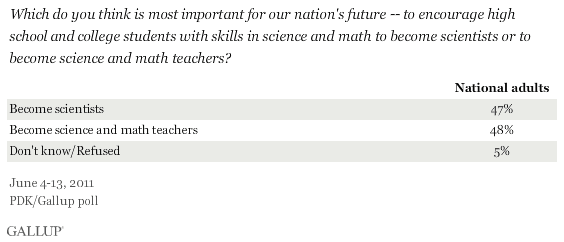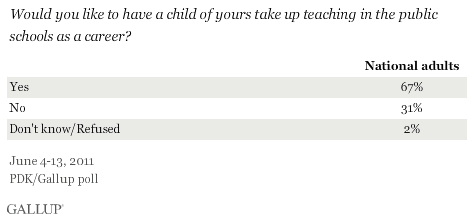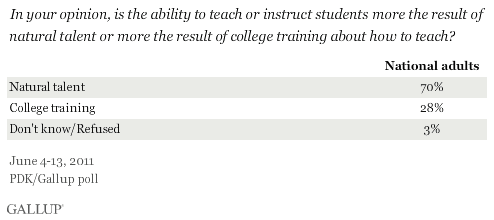WASHINGTON, D.C. -- Americans support the idea of encouraging the nation's best and brightest people to become teachers, according to findings from the 43rd annual Phi Delta Kappa (PDK)/Gallup poll. The large majority support recruiting high-achieving high school students to become teachers, and 74% would encourage the brightest person they know to become a teacher should he or she express an interest in doing so.

Americans are evenly divided, however, in their views of whether it is more important to the nation's future for those with strong math and science skills to become science and math teachers or to become scientists.

Importantly, Americans do not just support people in general becoming teachers, but also extend their encouragement to their own family members. Two out of three would like a child of their own to become a public school teacher, a finding consistent with 2010 poll results.

Americans Say Ability to Teach Is a Natural Talent
The vast majority of Americans believe a person's ability to teach comes more from natural talent than from college training about how to teach. Given this finding, Americans may be more likely to favor programs that identify those who have natural teaching abilities over broad recruitment efforts.

The belief that teaching ability is more from talent than from training may explain why the PDK/Gallup poll finds that more than half of Americans (52%) think that their local public school system has a hard time finding good teachers.
Bottom Line
Americans believe that the best and the brightest people, including their own children, should be encouraged if not actively recruited to become teachers to meet what they see as a current need for great teachers. Talented teachers are more necessary than ever as American students compete with those in other countries on international assessments such as the Program for International Student Assessment.
According to a 2011 report from McGraw-Hill and the Organization for Economic Cooperation and Development, countries that have invested in improving teacher quality have realized the largest gains in student achievement. The report's authors note that "[T]eaching education programs in the high-performing nations tend to be more selective and more rigorous than in the U.S." The results from this year's PDK/Gallup poll reveal there is a strong public will in the United States for such efforts.
Additionally, when Gallup asked in an open-ended format what would be the best way to improve education in the U.S., the response Americans mentioned most often was better teachers. Americans are likely to support strategic recruiting initiatives that would bring the best and the brightest high school and college students, and those who have demonstrated talent for teaching, into the education profession.
Survey Methods
Results for this PDK/Gallup poll are based telephone interviews with 1,002 adults nationally, aged 18 and older randomly selected from the Gallup Panel, conducted June 4-13, 2011. Gallup Panel members are recruited through random sampling methods. The sample included an oversample of Panel members who reported having a child aged 5 to 18 in the household. The sample is weighted to be demographically representative of the U.S. adult population and to represent the proper proportion of parents with children between ages 5 and 18.
For results based on the total sample of national adults, one can say with 95% confidence that the maximum margin of sampling error is ±4 percentage points.
Interviews are conducted with respondents on landline telephones and cellular phones, with interviews conducted in Spanish for respondents who are primarily Spanish-speaking. Each sample includes a minimum quota of 400 cell phone respondents and 600 landline respondents per 1,000 national adults, with additional minimum quotas among landline respondents by region. Landline telephone numbers are chosen at random among listed telephone numbers. Cell phone numbers are selected using random-digit-dial methods. Landline respondents are chosen at random within each household on the basis of which member had the most recent birthday.
Samples are weighted by gender, age, race, Hispanic ethnicity, education, region, adults in the household, and phone status (cell phone only/landline only/both, cell phone mostly, and having an unlisted landline number). Demographic weighting targets are based on the March 2010 Current Population Survey figures for the aged 18 and older non-institutionalized population living in U.S. telephone households. All reported margins of sampling error include the computed design effects for weighting and sample design.
In addition to sampling error, question wording and practical difficulties in conducting surveys can introduce error or bias into the findings of public opinion polls.
For more details on Gallup's polling methodology, visit www.gallup.com.
